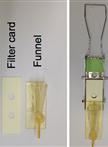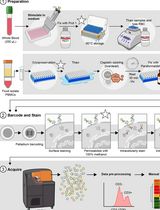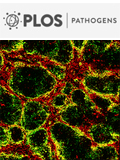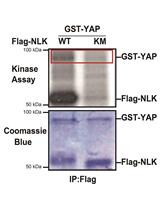- EN - English
- CN - 中文
Unbiased Screening of Activated Receptor Tyrosine Kinases (RTKs) in Tumor Extracts Using a Mouse Phospho-RTK Array Kit
利用小鼠Phospho-RTK Array试剂盒无偏筛选肿瘤提取物中激活受体酪氨酸激酶
发布: 2019年04月20日第9卷第8期 DOI: 10.21769/BioProtoc.3216 浏览次数: 5634
评审: Chiara AmbrogioValerian DORMOYAnonymous reviewer(s)

相关实验方案

免疫荧光原位杂交法(IF-FISH)检测ALT相关的前髓细胞性白血病核体(APB)
Siamak A. Kamranvar and Maria G. Masucci
2014年12月05日 14353 阅读

用于比较人冷冻保存 PBMC 与全血中 JAK/STAT 信号通路的双磷酸化 CyTOF 流程
Ilyssa E. Ramos [...] James M. Cherry
2025年11月20日 2120 阅读
Abstract
Kaposi’s sarcoma (KS) herpesvirus (KSHV) is a virus that causes KS, an angiogenic AIDS-associated spindle-cell neoplasm, by activating host oncogenic signaling cascades through autocrine and paracrine mechanisms. Many host signaling cascades co-opted by KSHV including PI3K/AKT/mTORC, NFkB and Notch are critical for cell-specific mechanisms of transformation and their identification is paving the way to therapeutic target discovery. Analysis of the molecular KS signature common to human KS tumors and our mouse KS-like tumors showed consistent expression of KS markers VEGF and PDGF receptors with upregulation of other angiogenesis ligands and their receptors in vivo. This points to the autocrine and paracrine activation of various receptor tyrosine kinase (RTK) signaling axes. Hereby we describe a protocol to screen for activated receptor tyrosine kinase of KSHV-induced KS-like mouse tumors using a Mouse Phospho-RTK Array Kit and its validation by RTK western blots. We showed that this method can be successfully used to rank the tyrosine kinase receptors most activated in tumors in an unbiased manner. This allowed us to identify PDGFRA as an oncogenic driver and therapeutic target in AIDS-KS.
Keywords: PDGFRA (血小板源性生长因子受体α多肽)Background
Kaposi’s sarcoma herpesvirus (KSHV) is the etiological agent of Kaposi’s sarcoma (KS) (Chang et al., 1994; Ganem, 2010; Mesri et al., 2010; Dittmer and Damania, 2016). KS is a major cancer associated with AIDS (AIDS-KS) and is the most prevalent type of cancer affecting men and children in Africa (Ganem, 2010; Mesri et al., 2010; Cavallin et al., 2014). Although the incidence of AIDS-KS in the western world has markedly declined since the wide-spread implementation of HAART (Highly Active Antiretroviral Therapy), a significant percentage of AIDS-KS patients never achieve total remission (Krown, 2003; Nguyen et al., 2008; Cavallin et al., 2014). Moreover, KSHV prevalence and KS incidence appear to be increasing, even in HAART treated HIV patients with controlled viremias (Maurer et al., 2007; Labo et al., 2015). Understanding the interplay of viral and host factors in KS oncogenesis is critical for the rational development of new therapies (Dittmer and Krown, 2007; Sullivan et al., 2009). Many host signaling cascades co-opted by KSHV including PI3K/AKT/mTORC, NFkB and Notch are critical for cell-specific mechanisms of transformation and their identification is paving the way to therapeutic target discovery (Sodhi et al., 2006; Emuss et al., 2009; Liu et al., 2010; Mesri et al., 2014; Dittmer and Damania, 2016). Analysis of the molecular KS signature common to human KS tumors and our mouse KS-like tumors, showed consistent expression of KS markers VEGFR 1, 2, 3, Podoplanin with upregulation of angiogenesis ligands and receptors in vivo, pointing to the upregulation of various receptor tyrosine kinase signaling axes (Mutlu et al., 2007; Mesri et al., 2010). Thus, we set out to rank the host tyrosine kinase signaling cascades activated by KSHV using a mouse model of KSHV-dependent tumorigenesis that helped us to identify PDGFRA as an oncogenic driver and therapeutic target in AIDS-KS (Cavallin et al., 2018).
Here we describe an assay protocol using a Mouse Phospho-RTK Array Kit in mouse KSHV-induced KS-like tumors, which can be used as a reliable method to rank the tyrosine kinase receptors most activated in tumors in an unbiased manner. The Proteome Profiler Mouse Phospho-RTK Array Kit (R&D Systems) is a membrane-based sandwich immunoassay. Captured antibodies spotted in duplicate on nitrocellulose membranes bind to specific target proteins present in the sample. Tyrosine phosphorylation of the captured proteins is detected with an HRP-conjugated pan phospho-tyrosine antibody and then visualized using chemiluminescent detection reagents. The signal produced is proportional to the amount phosphorylation in the bound analyte.
Surprisingly, analysis of the pattern of tumor RTK activation (Figures 1 and 2) showed a single prominently activated RTK spot that accounted for a significant portion of the total tyrosine kinase activation of the tumors. This signal corresponded to the PDGF receptor alpha-chain (PDGFRA) (Cavallin et al., 2018). Validation of the array by Western Blot analysis (Figure 3A) shows that PDGFRA is robustly expressed and much more phosphorylated in the tumors than in mouse normal skin. On the other hand, c-kit (Figure 3B), a related RTK, is similarly expressed in skin and tumors and displays low levels of activation in the tumors; that are similar to those in the skin control and correlates with the low activation of c-kit in our phospho-tyrosine kinase proteomic array (Cavallin et al., 2018).
Materials and Reagents
Common lab consumables
- Pipette tips
- Gloves
- Plastic containers with the capacity to hold 50 ml (for washing the arrays)
- Plastic wrap
- Absorbent lab wipes (KimWipes® or equivalent)
- Paper towels
- Plastic transparent sheet protector (trimmed to 10 cm x 12 cm and open on three sides)
- TissueRuptor Disposable Probes (QIAGEN, catalog number: 990890)
Reagent Preparation (Mouse Phospho-RTK Array Kit)
- Proteome Profiler Mouse Phospho-RTK Array Kit (R&D Systems, catalog number: ARY014)
Kit Contents:- 4 Array Membranes
- 4-Well Multi-dish
- Array Buffers:1)Lysis Buffer 17 (see Recipes)2)Array Buffer 13)1x Array Buffer 2 (see Recipes)4)1x Wash Buffer (see Recipes)5)Chemi Reagent Mix (see Recipes)
- Lysis Buffer
- Wash Buffer
- Anti-Phospho-Tyrosine-HRP Detection Antibody
- Chemiluminescent Detection Reagents
- Transparency Overlay Template
- Detailed Protocol
- Aprotinin (Sigma, catalog number: A6279)
- Leupeptin (Tocris, catalog number: 1167)
- Pepstatin (Tocris, catalog number: 1190)
Materials and reagents for Western blots
- PDVF membranes
- CL-XPosureTM Film, 5 x 7 in. (13 x 18 cm) (Thermo Fisher Scientific, catalog number: 34090)
- 4x Laemmli Sample Buffer (Bio-Rad Laboratories, catalog number: 1610747)
- 4%-20% Mini-PROTEAN® TGX Stain-FreeTM Protein Gels, 12-well, 20 µl (Bio-Rad Laboratories, catalog number: 4568095)
- 10x Tris/Glycine Buffer for Western Blots and Native Gels (Bio-Rad Laboratories, catalog number: 1610771)
- 10x Tris/Glycine/SDS (Bio-Rad Laboratories, catalog number: 1610772)
- Methanol ACS reagent, ≥ 99.8% (Sigma, catalog number: 179337)
- PierceTM BCA Protein Assay Kit (Thermo Scientific, catalog number: 23227)
- Blotting-Grade Blocker, nonfat dry milk (Bio-Rad Laboratories, catalog number: 1706404)
- Tween 20, 100% Nonionic Detergent (Bio-Rad Laboratories, catalog number: 1706531)
- TBS Buffer, 20x liquid (VWR, catalog number: 97064-338)
- RestoreTM PLUS Western Blot Stripping Buffer (Thermo Scientific, catalog number: 46430)
- SuperSignalTM West Pico PLUS Chemiluminescent Substrate (Thermo Scientific, catalog number: 34577)
- Primary Antibodies:
cKIT and p-cKIT (Cell Signaling Technology, catalog number: 9370)
PDGFRA and p-PDGFRA (R&D Systems, catalog numbers: AF307 and AF2114) - HRP-labeled secondary antibodies (Promega, catalog number: W4011)
- Deionized or distilled water
- 1x Tris/Glycine running buffer (see Recipes)
- Transfer buffer (see Recipes)
- 1x TBS (1 L) (see Recipes)
- TBS/Tween (see Recipes)
- 5% Blotting-Grade Blocker, nonfat dry milk/TBS/Tween (see Recipes)
Equipment
- Pipettes (Gilson, Pipetman Classic)
- Flat-tipped tweezers
- Autoradiography cassette
- Rocking platform shaker
- TissueRuptor II (QIAGEN, catalog number: 9002755)
- Centrifuge 5810R (Eppendorf, catalog number: 5811000010)
- Film developer Alphatek AX-390-SE (Alphatek)
- Rocking platform shaker
Software
- Protein Array Analyzer for ImageJ (Author: Gilles Carpentier, Faculte des Sciences et Technologies, Universite Paris Est Creteil Val de Marne, France, https://imagej.nih.gov/ij/macros/toolsets/Protein%20Array%20Analyzer.txt)
- GraphPad Prism 7.0a (GraphPad Software, Inc., www.graphpad.com)
Procedure
文章信息
版权信息
© 2019 The Authors; exclusive licensee Bio-protocol LLC.
如何引用
Naipauer, J., Cavallin, L. E. and Mesri, E. A. (2019). Unbiased Screening of Activated Receptor Tyrosine Kinases (RTKs) in Tumor Extracts Using a Mouse Phospho-RTK Array Kit. Bio-protocol 9(8): e3216. DOI: 10.21769/BioProtoc.3216.
分类
癌症生物学 > 增殖信号转导 > 生物化学试验 > 蛋白质分析
微生物学 > 体内实验模型 > 病毒
分子生物学 > 蛋白质 > 磷酸化
您对这篇实验方法有问题吗?
在此处发布您的问题,我们将邀请本文作者来回答。同时,我们会将您的问题发布到Bio-protocol Exchange,以便寻求社区成员的帮助。
Share
Bluesky
X
Copy link









